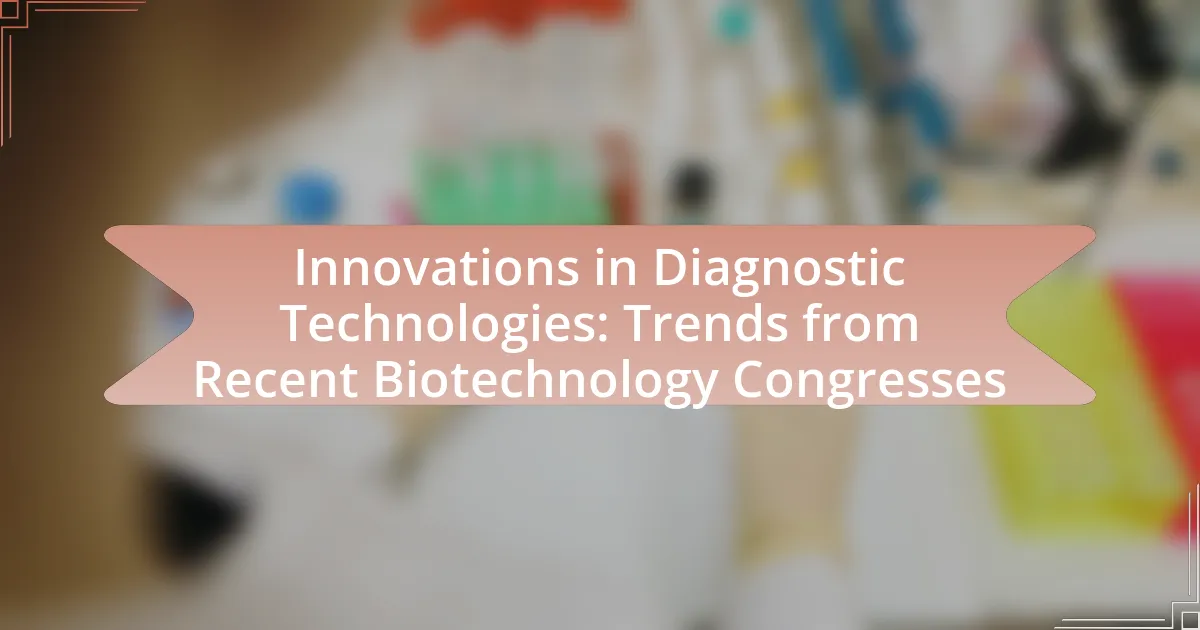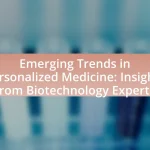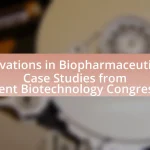The article focuses on the latest innovations in diagnostic technologies, highlighting advancements such as liquid biopsy, artificial intelligence (AI) integration, and point-of-care testing. It discusses how recent biotechnology congresses have facilitated collaboration among researchers and industry leaders, leading to breakthroughs in CRISPR gene editing, next-generation sequencing, and personalized medicine approaches. Key themes include the role of AI in enhancing diagnostic accuracy, the impact of genomics on precision medicine, and the regulatory challenges faced by new diagnostic tools. The article emphasizes the importance of interdisciplinary collaboration and outlines practical steps for implementing these innovations in healthcare settings.
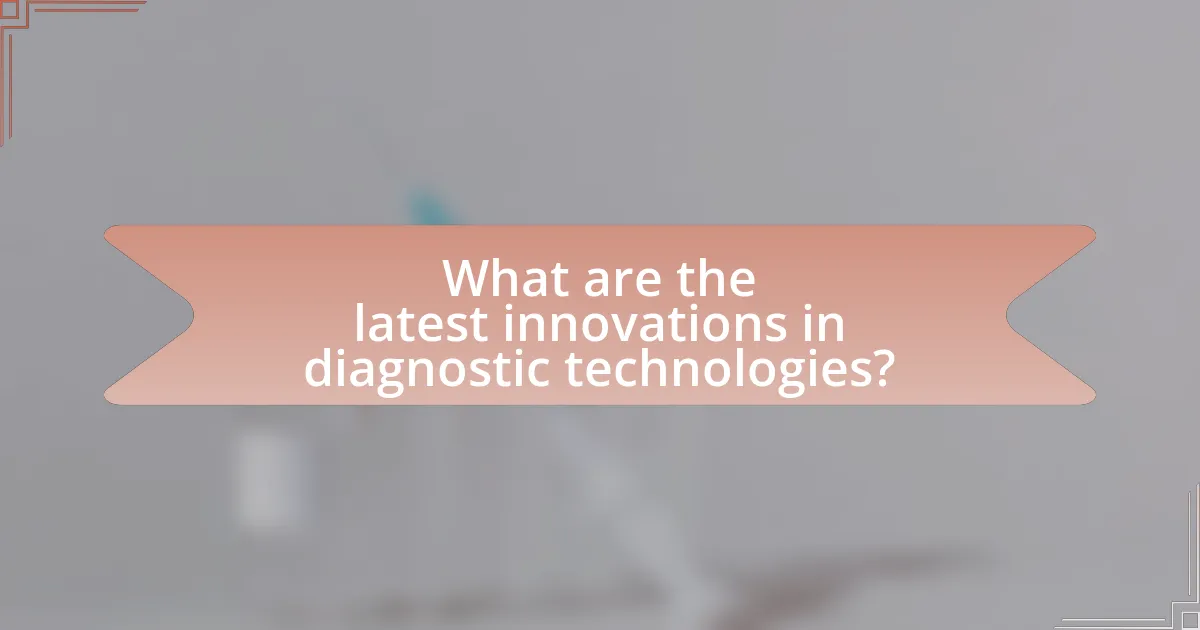
What are the latest innovations in diagnostic technologies?
The latest innovations in diagnostic technologies include advancements in liquid biopsy, artificial intelligence (AI) integration, and point-of-care testing. Liquid biopsy techniques enable non-invasive cancer detection through the analysis of circulating tumor DNA, significantly improving early diagnosis and monitoring. AI integration enhances diagnostic accuracy by analyzing complex medical data, with studies showing AI algorithms outperforming human radiologists in identifying certain conditions. Point-of-care testing innovations allow for rapid diagnostics at the site of care, facilitating immediate clinical decision-making and improving patient outcomes. These innovations are supported by research presented at recent biotechnology congresses, highlighting their potential to transform healthcare diagnostics.
How have recent biotechnology congresses influenced these innovations?
Recent biotechnology congresses have significantly influenced innovations in diagnostic technologies by facilitating collaboration among researchers, industry leaders, and policymakers. These events have served as platforms for sharing cutting-edge research, showcasing novel diagnostic tools, and discussing regulatory challenges. For instance, the 2023 Biotechnology Innovation Organization (BIO) International Convention highlighted advancements in CRISPR-based diagnostics, which have shown promise in rapid pathogen detection. Additionally, networking opportunities at these congresses have led to partnerships that accelerate the development and commercialization of new diagnostic solutions, as evidenced by the increased number of startups emerging from discussions held at these events.
What key themes emerged from the latest congresses?
Key themes that emerged from the latest congresses include advancements in artificial intelligence for diagnostics, integration of personalized medicine, and the development of point-of-care testing technologies. These themes reflect a growing emphasis on enhancing diagnostic accuracy and efficiency. For instance, the use of AI algorithms has been shown to improve diagnostic outcomes by analyzing complex data sets more effectively than traditional methods. Additionally, personalized medicine is gaining traction as it allows for tailored treatment plans based on individual genetic profiles, which was highlighted in multiple presentations at the congresses. Furthermore, innovations in point-of-care testing are making diagnostics more accessible, enabling quicker decision-making in clinical settings.
Which technologies were highlighted as breakthroughs?
The technologies highlighted as breakthroughs include CRISPR gene editing, next-generation sequencing (NGS), and artificial intelligence (AI) in diagnostics. CRISPR has revolutionized genetic engineering by allowing precise modifications to DNA, which has significant implications for disease treatment and prevention. Next-generation sequencing has dramatically reduced the time and cost of sequencing genomes, enabling personalized medicine and advanced research in genomics. Artificial intelligence is transforming diagnostics by improving the accuracy and speed of disease detection through advanced data analysis and pattern recognition. These technologies have been recognized for their potential to enhance diagnostic capabilities and improve patient outcomes in the field of biotechnology.
What role do emerging technologies play in diagnostics?
Emerging technologies play a crucial role in diagnostics by enhancing accuracy, speed, and accessibility of medical testing. Innovations such as artificial intelligence, machine learning, and advanced imaging techniques enable healthcare professionals to analyze complex data more effectively, leading to quicker and more precise diagnoses. For instance, AI algorithms can process medical images with a diagnostic accuracy comparable to that of experienced radiologists, as demonstrated in studies published in journals like Nature and The Lancet. Additionally, point-of-care testing technologies allow for rapid diagnostics in various settings, improving patient outcomes by facilitating timely treatment decisions.
How is artificial intelligence transforming diagnostic processes?
Artificial intelligence is transforming diagnostic processes by enhancing accuracy and efficiency in disease detection and analysis. AI algorithms, particularly those utilizing machine learning, can analyze vast datasets, including medical images and patient records, to identify patterns that may be missed by human clinicians. For instance, studies have shown that AI systems can achieve diagnostic accuracy rates comparable to or exceeding those of expert radiologists in detecting conditions like breast cancer, with some algorithms reporting sensitivity rates above 94%. This capability not only speeds up the diagnostic process but also reduces the likelihood of human error, ultimately leading to improved patient outcomes.
What advancements in imaging technologies are being discussed?
Advancements in imaging technologies being discussed include the development of high-resolution 3D imaging techniques, artificial intelligence integration for enhanced image analysis, and the use of molecular imaging to provide real-time insights into biological processes. High-resolution 3D imaging techniques, such as optical coherence tomography, allow for detailed visualization of tissues, improving diagnostic accuracy. Artificial intelligence algorithms are increasingly utilized to analyze imaging data, significantly reducing interpretation time and increasing diagnostic precision. Molecular imaging, which employs specific biomarkers, enables visualization of cellular processes in vivo, facilitating early disease detection and personalized treatment strategies. These advancements are supported by recent studies highlighting their effectiveness in clinical applications, demonstrating improved patient outcomes and diagnostic capabilities.
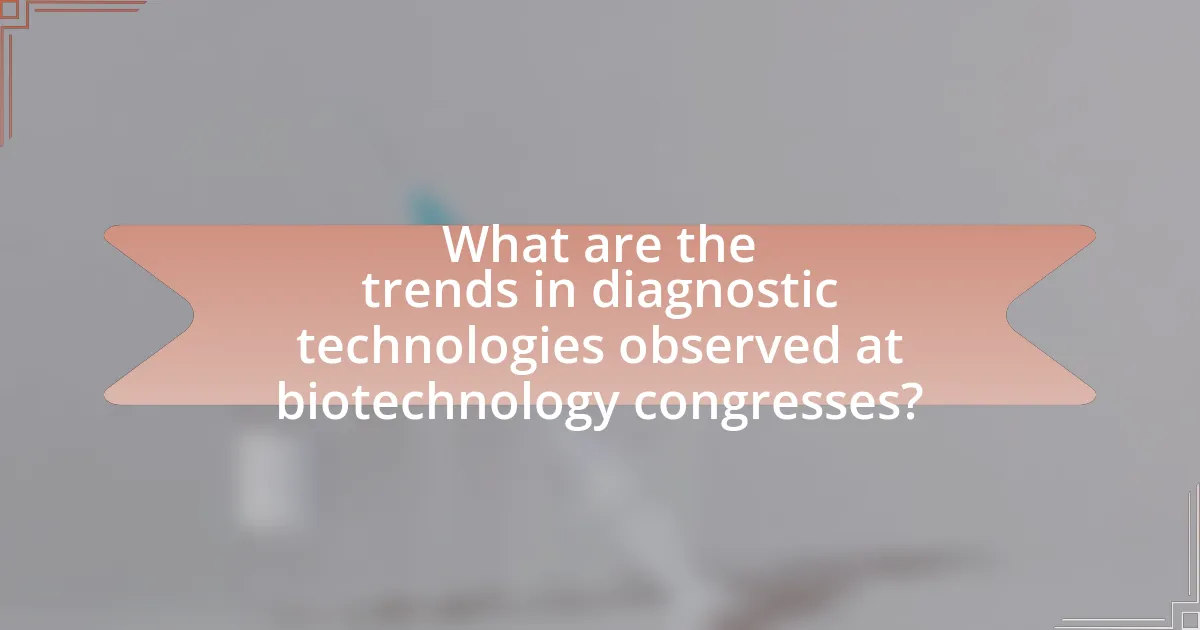
What are the trends in diagnostic technologies observed at biotechnology congresses?
Recent biotechnology congresses have highlighted several key trends in diagnostic technologies, including the rise of point-of-care testing, advancements in molecular diagnostics, and the integration of artificial intelligence in data analysis. Point-of-care testing has gained traction due to its ability to provide rapid results, facilitating timely clinical decisions. Molecular diagnostics, particularly next-generation sequencing, has seen increased adoption for its precision in detecting genetic mutations and infectious diseases. Additionally, the incorporation of artificial intelligence enhances the interpretation of complex data sets, improving diagnostic accuracy and efficiency. These trends reflect a shift towards more accessible, precise, and efficient diagnostic solutions in the biotechnology field.
How are personalized medicine approaches shaping diagnostics?
Personalized medicine approaches are significantly shaping diagnostics by enabling tailored testing that aligns with individual genetic profiles. This shift allows for more accurate disease prediction, prevention, and treatment strategies, as evidenced by the integration of genomic sequencing in clinical settings, which has increased the precision of diagnoses for conditions like cancer. For instance, the use of targeted therapies based on specific genetic mutations has improved patient outcomes, with studies showing that patients receiving personalized treatment regimens have a higher response rate compared to those on standard therapies. This evolution in diagnostics not only enhances the effectiveness of medical interventions but also streamlines the healthcare process by reducing trial-and-error prescribing, ultimately leading to more efficient use of healthcare resources.
What are the implications of genomics on diagnostic accuracy?
Genomics significantly enhances diagnostic accuracy by enabling precise identification of genetic mutations associated with diseases. This precision allows for earlier detection and more tailored treatment options, improving patient outcomes. For instance, genomic testing can identify specific mutations in cancers, leading to targeted therapies that are more effective than traditional treatments. Studies have shown that incorporating genomic data into diagnostic processes can increase accuracy rates by up to 30%, as evidenced by research published in the Journal of Clinical Oncology, which highlights the role of genomic profiling in improving the diagnostic landscape for various cancers.
How is patient data being utilized for improved diagnostics?
Patient data is utilized for improved diagnostics through advanced analytics and machine learning algorithms that enhance the accuracy of disease detection. By analyzing large datasets, healthcare providers can identify patterns and correlations that may not be evident through traditional diagnostic methods. For instance, studies have shown that machine learning models can achieve diagnostic accuracy rates exceeding 90% in areas such as radiology and pathology by leveraging patient data, including imaging results and clinical histories. This data-driven approach not only streamlines the diagnostic process but also enables personalized treatment plans, ultimately improving patient outcomes.
What regulatory challenges are impacting diagnostic innovations?
Regulatory challenges impacting diagnostic innovations include stringent approval processes, inconsistent regulatory frameworks across regions, and the need for extensive clinical validation. These challenges hinder the timely introduction of new diagnostic technologies into the market. For instance, the U.S. Food and Drug Administration (FDA) requires comprehensive data demonstrating safety and efficacy, which can prolong the approval timeline. Additionally, varying regulations in Europe and Asia create complexities for companies seeking to launch products globally, often resulting in increased costs and delays. The lack of harmonization in regulatory standards can stifle innovation, as companies may be deterred from investing in new diagnostic solutions due to uncertainty in regulatory pathways.
How do regulations affect the development of new diagnostic tools?
Regulations significantly influence the development of new diagnostic tools by establishing safety, efficacy, and quality standards that must be met before market approval. These regulatory frameworks, such as those enforced by the FDA in the United States or the EMA in Europe, require extensive clinical testing and validation processes, which can prolong the time to market and increase development costs. For instance, the FDA’s 510(k) process mandates that new diagnostic tools demonstrate substantial equivalence to existing products, which can limit innovation by creating barriers for novel technologies. Additionally, compliance with regulations often necessitates rigorous documentation and quality control measures, impacting the overall design and development workflow of diagnostic tools.
What are the compliance requirements for new technologies?
Compliance requirements for new technologies typically include adherence to regulatory standards, data protection laws, and industry-specific guidelines. For instance, in the biotechnology sector, technologies must comply with regulations set by agencies such as the FDA in the United States, which mandates rigorous testing and validation processes to ensure safety and efficacy. Additionally, compliance with the General Data Protection Regulation (GDPR) is essential for technologies that handle personal data, ensuring that user privacy is protected. These requirements are critical for maintaining public trust and ensuring that innovations in diagnostic technologies are both safe and effective.
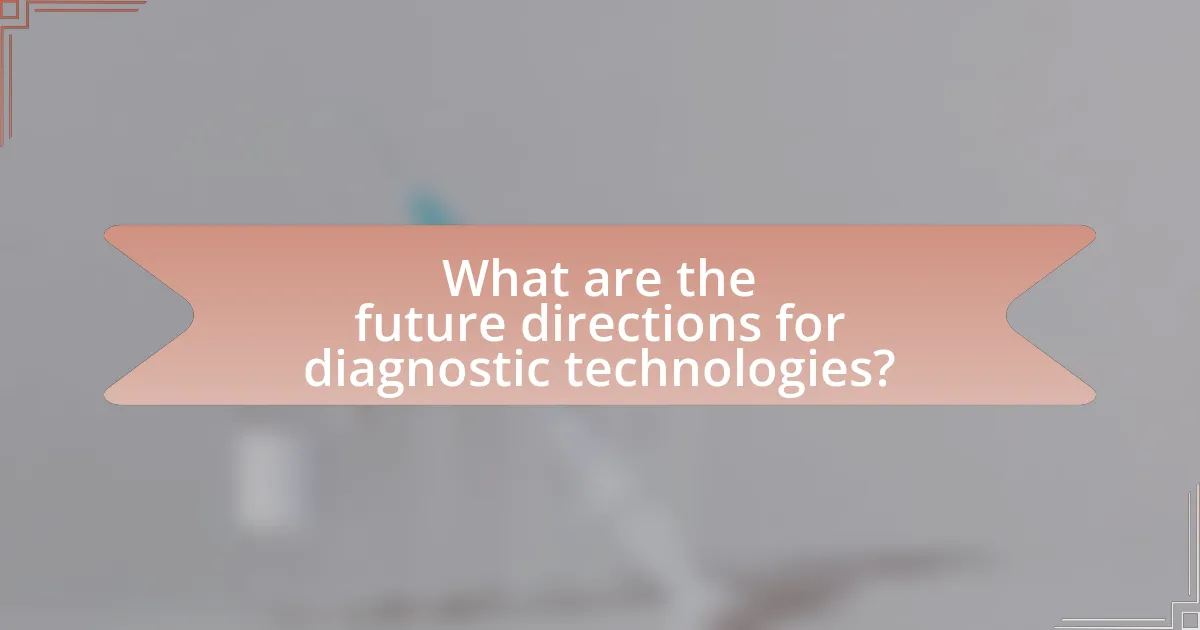
What are the future directions for diagnostic technologies?
Future directions for diagnostic technologies include the integration of artificial intelligence and machine learning to enhance accuracy and speed in disease detection. These advancements are expected to facilitate personalized medicine by enabling more precise diagnostics tailored to individual patient profiles. For instance, AI algorithms can analyze vast datasets from genomic sequencing to identify biomarkers associated with specific diseases, improving early detection rates. Additionally, point-of-care testing is anticipated to expand, allowing for rapid diagnostics in diverse settings, which can significantly reduce the time to treatment. The rise of non-invasive testing methods, such as liquid biopsies, is also a key trend, as they offer safer and more convenient options for monitoring disease progression. These directions are supported by ongoing research and development efforts presented at recent biotechnology congresses, highlighting the commitment to advancing diagnostic capabilities in healthcare.
How will collaboration between biotech companies and researchers evolve?
Collaboration between biotech companies and researchers will evolve towards more integrated partnerships that leverage shared resources and expertise. This evolution is driven by the increasing complexity of biotechnological challenges, which require multidisciplinary approaches and rapid innovation cycles. For instance, recent trends indicate that biotech firms are increasingly engaging in open innovation models, where they collaborate with academic institutions to co-develop diagnostic technologies, as seen in partnerships highlighted at the Biotechnology Innovation Organization’s annual conference. These collaborations often result in accelerated research timelines and enhanced access to cutting-edge technologies, ultimately leading to more effective diagnostic solutions.
What partnerships are currently being formed to advance diagnostics?
Partnerships currently being formed to advance diagnostics include collaborations between biotechnology companies and healthcare institutions aimed at developing innovative diagnostic tools. For instance, a recent partnership between Illumina and the University of California aims to enhance genomic sequencing technologies for better disease detection. Additionally, Roche has partnered with various academic institutions to integrate artificial intelligence into diagnostic processes, improving accuracy and speed. These collaborations are supported by funding from government grants and private investments, which facilitate research and development in diagnostic technologies.
How can interdisciplinary approaches enhance diagnostic innovation?
Interdisciplinary approaches enhance diagnostic innovation by integrating diverse expertise and methodologies, leading to more comprehensive solutions. For instance, collaboration between biologists, data scientists, and engineers can result in the development of advanced diagnostic tools that leverage machine learning algorithms to analyze complex biological data. A study published in the journal Nature Biotechnology highlights that interdisciplinary teams can accelerate the discovery of biomarkers for diseases by combining insights from genomics, proteomics, and computational biology, ultimately improving diagnostic accuracy and speed. This integration of knowledge not only fosters creativity but also addresses multifaceted challenges in diagnostics, making it a crucial strategy for innovation in the field.
What practical steps can be taken to implement these innovations?
To implement innovations in diagnostic technologies, organizations should first conduct a comprehensive assessment of current capabilities and identify gaps that these innovations can fill. Following this, they should establish partnerships with biotechnology firms and research institutions to access cutting-edge technologies and expertise. Next, organizations must invest in training programs for staff to ensure they are equipped to utilize new diagnostic tools effectively. Additionally, securing funding through grants or collaborations can facilitate the acquisition of necessary resources. Finally, pilot testing the innovations in controlled environments allows for evaluation and refinement before full-scale implementation. These steps are supported by the increasing trend of collaboration between academia and industry, as highlighted in recent biotechnology congresses, which emphasize the importance of partnerships in advancing diagnostic technologies.
What best practices should be followed for adopting new diagnostic technologies?
To adopt new diagnostic technologies effectively, organizations should follow best practices such as conducting thorough evaluations of the technology’s clinical validity and utility, ensuring compliance with regulatory standards, and engaging stakeholders throughout the implementation process. Evaluating clinical validity involves assessing the accuracy and reliability of the diagnostic tests, which is crucial for patient safety and treatment efficacy. Compliance with regulatory standards, such as those set by the FDA or CE marking in Europe, ensures that the technology meets necessary safety and effectiveness criteria. Engaging stakeholders, including healthcare providers and patients, fosters acceptance and facilitates smoother integration into existing workflows. These practices are supported by studies indicating that structured adoption processes lead to improved outcomes and reduced implementation challenges in healthcare settings.
How can healthcare providers prepare for upcoming diagnostic advancements?
Healthcare providers can prepare for upcoming diagnostic advancements by investing in continuous education and training for their staff. This approach ensures that healthcare professionals remain updated on the latest technologies and methodologies, which is crucial as diagnostic tools evolve rapidly. For instance, the integration of artificial intelligence in diagnostics has shown to improve accuracy and efficiency, as evidenced by a study published in the Journal of the American Medical Association, which reported a 20% increase in diagnostic accuracy when AI tools were utilized. Additionally, healthcare providers should establish partnerships with technology developers to facilitate early access to new diagnostic tools and participate in pilot programs. This proactive engagement allows providers to adapt their workflows and improve patient care outcomes effectively.
